check engine SKODA SUPERB 2009 2.G / (B6/3T) User Guide
[x] Cancel search | Manufacturer: SKODA, Model Year: 2009, Model line: SUPERB, Model: SKODA SUPERB 2009 2.G / (B6/3T)Pages: 294, PDF Size: 21.33 MB
Page 43 of 294
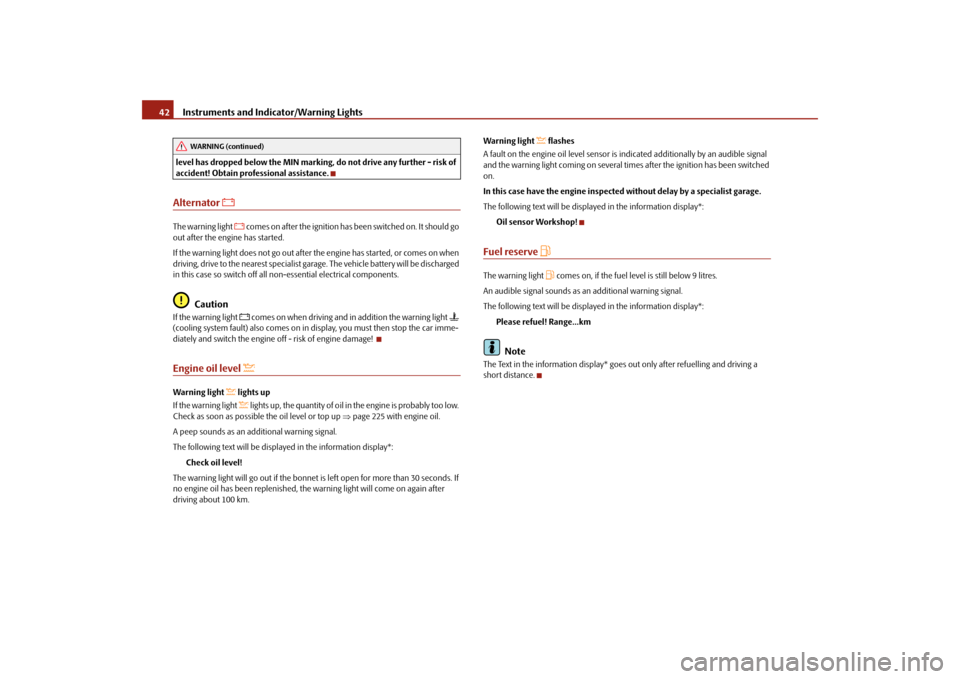
Instruments and Indicator/Warning Lights
42
level has dropped below the MIN marking, do not drive any further - risk of accident! Obtain professional assistance.Alternator
The warning light
comes on after the ignition has been switched on. It should go
out after the engine has started. If the warning light does not go out after the engine has started, or comes on when driving, drive to the nearest specialist garage. The vehicle battery will be discharged in this case so switch off all non-essential electrical components.
Caution
If the warning light
comes on when driving and in addition the warning light
(cooling system fault) also comes on in display, you must then stop the car imme- diately and switch the engine
off - risk of engine damage!
Engine oil level
Warning light
lights up
If the warning light
lights up, the quantity of oil in the engine is probably too low.
Check as soon as possible
the oil level or top up
⇒page 225 with engine oil.
A peep sounds as an additional warning signal.The following text will be displayed in the information display*:
Check oil level!
The warning light will go out if the bonnet
is left open for more than 30 seconds. If
no engine oil has been replenished, th
e warning light will come on again after
driving about 100 km.
Warning light
flashes
A fault on the engine oil level sensor is indicated additionally by an audible signal and the warning light coming on several times after the ignition has been switched on. In this case have the engine inspected without delay by a specialist garage.The following text will be displayed in the information display*:
Oil sensor Workshop!
Fuel reserve
The warning light
comes on, if the fuel level is still below 9 litres.
An audible signal sounds as an additional warning signal.The following text will be displayed in the information display*:
Please refuel! Range...kmNote
The Text in the information display* goes out only after refuelling and driving a short distance.
WARNING (continued)
s2dk.1.book Page 42 Wednesday, April 8, 2009 12:23 PM
Page 106 of 294
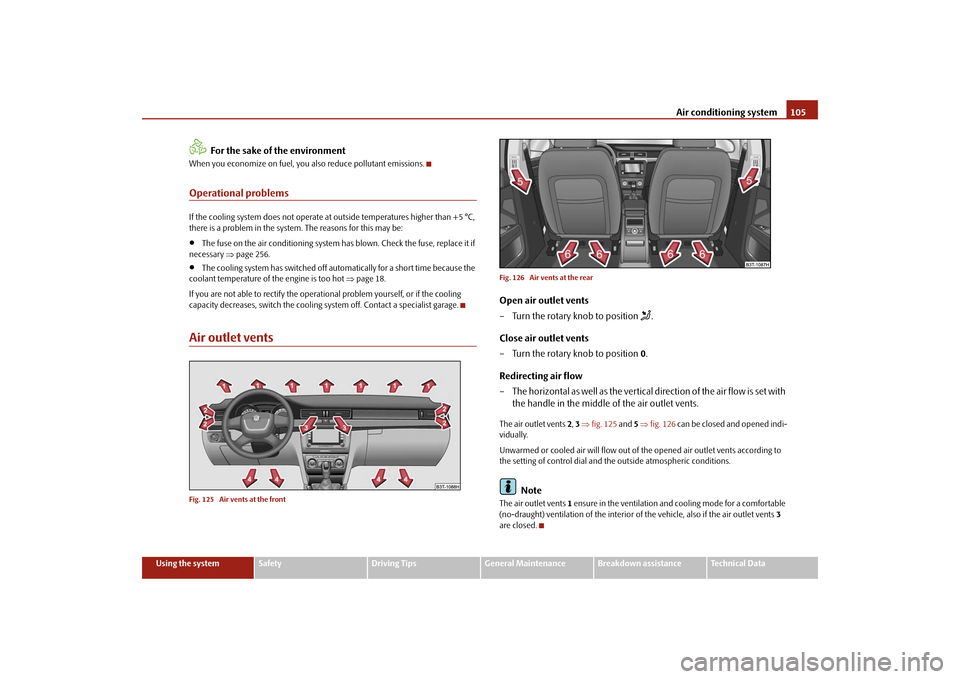
Air conditioning system
105
Using the system
Safety
Driving Tips
General Maintenance
Breakdown assistance
Technical Data
For the sake of the environment
When you economize on fuel, you
also reduce pollutant emissions.
Operational problemsIf the cooling system does not operate at outside temperatures higher than +5 °C, there is a problem in the system. The reasons for this may be:•
The fuse on the air conditioning system
has blown. Check the fuse, replace it if
necessary
⇒page 256.
•
The cooling system has switched off automatically for a short time because the
coolant temperature of the engine is too hot
⇒page 18.
If you are not able to rectify the operat
ional problem yourself, or if the cooling
capacity decreases, switch the cooling sy
stem off. Contact a specialist garage.
Air outlet ventsFig. 125 Air vents at the front
Fig. 126 Air vents at the rearOpen air outlet vents – Turn the rotary knob to position
.
Close air outlet vents – Turn the rotary knob to position
0.
Redirecting air flow – The horizontal as well as the vertical direction of the air flow is set with
the handle in the middle of the air outlet vents.
The air outlet vents
2, 3 ⇒fig. 125
and
5 ⇒fig. 126
can be closed and opened indi-
vidually. Unwarmed or cooled air will flow out of the opened air outlet vents according to the setting of control dial and the outside atmospheric conditions.
Note
The air outlet vents
1 ensure in the ventilation and cooling mode for a comfortable
(no-draught) ventilation of the interior of
the vehicle, also if the air outlet vents
3
are closed.
s2dk.1.book Page 105 Wednesday, April 8, 2009 12:23 PM
Page 120 of 294
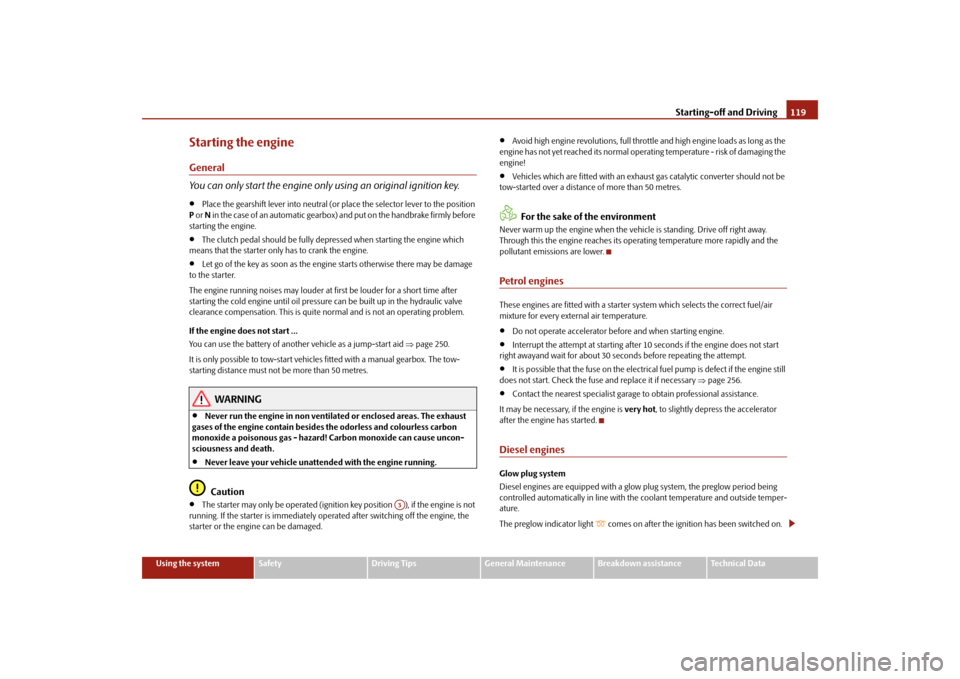
Starting-off and Driving
119
Using the system
Safety
Driving Tips
General Maintenance
Breakdown assistance
Technical Data
Starting the engineGeneral You can only start the engine only using an original ignition key.•
Place the gearshift lever into neutral (or place the selector lever to the position
P or N in the case of an automatic gearbox)
and put on the handbrake firmly before
starting the engine.•
The clutch pedal should be fully depressed when starting the engine which
means that the starter only
has to crank the engine.
•
Let go of the key as soon as the engine starts otherwise there may be damage
to the starter. The engine running noises may louder at
first be louder for
a short time after
starting the cold engine until oil pressure
can be built up in the hydraulic valve
clearance compensation. This is quite normal and is not an operating problem. If the engine does not start ... You can use the battery of anothe
r vehicle as a jump-start aid
⇒page 250.
It is only possible to tow-start vehicl
es fitted with a manual gearbox. The tow-
starting distance must not be more than 50 metres.
WARNING
•
Never run the engine in non ventilat
ed or enclosed areas. The exhaust
gases of the engine contain besides
the odorless and colourless carbon
monoxide a poisonous gas - hazard! Carbon monoxide can cause uncon- sciousness and death.•
Never leave your vehicle unattended with the engine running.Caution
•
The starter may only be operated (ignition key position ), if the engine is not
running. If the starter is immediately oper
ated after switching off the engine, the
starter or the engine can be damaged.
•
Avoid high engine revolutions, full throttl
e and high engine loads as long as the
engine has not yet reached it
s normal operating temperature - risk of damaging the
engine!•
Vehicles which are fitted wi
th an exhaust gas catalyti
c converter should not be
tow-started over a distance of more than 50 metres.
For the sake of the environment
Never warm up the engine when the vehi
cle is standing. Drive off right away.
Through this the engine reaches its operating temperature more rapidly and the pollutant emissions are lower.Petrol enginesThese engines are fitted with a starter system which selects the correct fuel/air mixture for every external air temperature.•
Do not operate accelerator before and when starting engine.
•
Interrupt the attempt at starting after
10 seconds if the engine does not start
right awayand wait for about 30 se
conds before repeating the attempt.
•
It is possible that the fuse on the electric
al fuel pump is defect if the engine still
does not start. Check the fuse and replace it if necessary
⇒page 256.
•
Contact the nearest specialist garage to obtain professional assistance.
It may be necessary, if the engine is
very hot
, to slightly depress the accelerator
after the engine has started.Diesel enginesGlow plug system Diesel engines are equipped with a glow
plug system, the preglow period being
controlled automatically in
line with the coolant temperature and outside temper-
ature. The preglow indicator light
comes on after the ignition has been switched on.
A3
s2dk.1.book Page 119 Wednesday, April 8, 2009 12:23 PM
Page 121 of 294
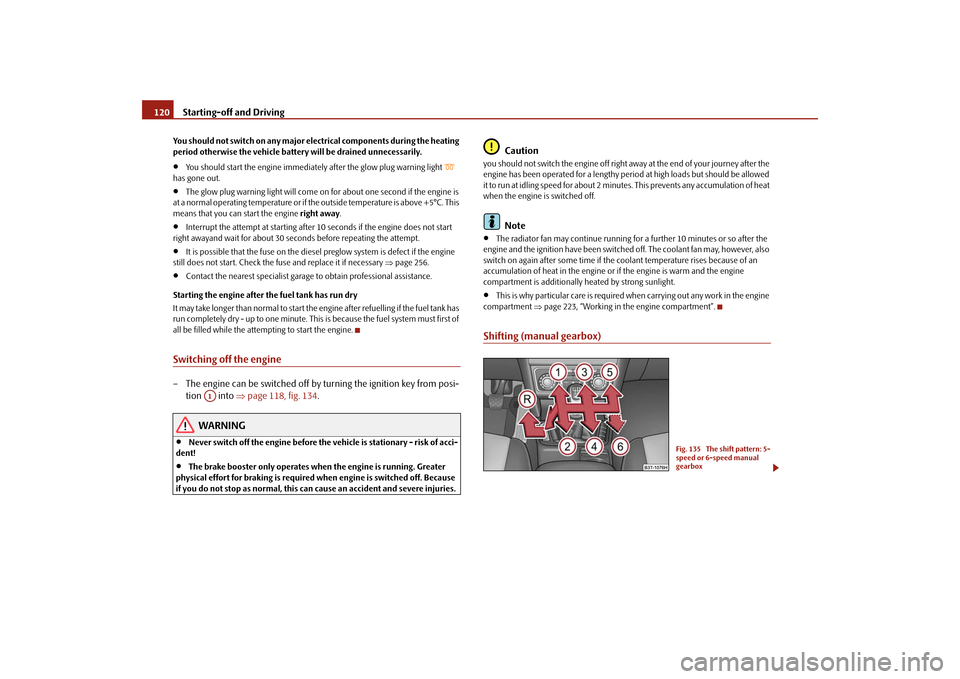
Starting-off and Driving
120
You should not switch on any major elec
trical components during the heating
period otherwise the vehicle battery
will be drained unnecessarily.
•
You should start the engine immediately after the glow plug warning light
has gone out.•
The glow plug warning light will come on for about one second if the engine is
at a normal operating temperature or if the outside temperature is above +5°C. This means that you can start the engine
right away
.
•
Interrupt the attempt at starting after 10 seconds if the engine does not start
right awayand wait for about 30 se
conds before repeating the attempt.
•
It is possible that the fuse on the diesel
preglow system is defect if the engine
still does not start. Check the fuse and replace it if necessary
⇒page 256.
•
Contact the nearest specialist garage to obtain professional assistance.
Starting the engine after the fuel tank has run dry It may take longer than normal to start the
engine after refuelling
if the fuel tank has
run completely dry - up to one minute. This is because the fuel system must first of all be filled while the attempting to start the engine.Switching off the engine– The engine can be swit
ched off by turning the ignition key from posi-
tion into
⇒
page 118, fig. 134
.
WARNING
•
Never switch off the engine before the
vehicle is stationary - risk of acci-
dent!•
The brake booster only operates when the engine is running. Greater
physical effort for braking is required
when engine is switched off. Because
if you do not stop as normal, this can cause an accident and severe injuries.
Caution
you should not switch the engine off right
away at the end of your journey after the
engine has been operated for a lengthy peri
od at high loads but should be allowed
it to run at idling speed for about 2 minut
es. This prevents any accumulation of heat
when the engine is switched off.
Note
•
The radiator fan may continue running fo
r a further 10 minutes or so after the
engine and the ignition have
been switched off. The coolant fan may, however, also
switch on again after some time if the coolant temperature rises because of an accumulation of heat in the engine or
if the engine is warm and the engine
compartment is additionally
heated by strong sunlight.
•
This is why particular care is required when carrying out any work in the engine
compartment
⇒page 223, “Working in the engine compartment”.
Shifting (manual gearbox)
A1
Fig. 135 The shift pattern: 5- speed or 6-speed manual gearbox
s2dk.1.book Page 120 Wednesday, April 8, 2009 12:23 PM
Page 205 of 294

Driving and the Environment
204
Avoiding full throttle Driving more slowly means saving fuel.Sensitive use of the accelera
tor will not only significantly reduce fuel consumption
but also positively influence environmen
tal pollution and wear of your vehicle.
You should avoid fully exploi
ting the top speed of your vehicle wherever possible.
Fuel consumption, pollutant emissions and vehicle noises increase disproportion- ally at high speeds. The
⇒fig. 195
shows the ratio of fuel consumption to the speed of your vehicle.
You will cut your fuel consumption by half
if you only make use three-quarters of
the possible top speed of your vehicle.Reducing idling Idling also costs fuel.It is worthwhile switching off the engine in
a traffic jam or when waiting at a level
crossing or at traffic lights with a length
y red phase. Even after just 30 - 40 seconds
you will have saved more fuel than that
is needed when you start the engine up
again. If an engine is only idling it takes much
longer for it to reach its normal operating
temperature. Wear-and-tear and pollutant em
issions, though, are particularly high
in the warming-up phase. This is why you
should drive off right after starting the
engine. Do avoid high engine re
volutions at this time, however.
Regular servicing A poorly tuned engine consumes an unnecessarily high amount of fuel.Having your vehicle serviced regularly at a specialist garge enables you to satisfy one
of the requirements for economical moto
ring even before you set off on your
journey. Keeping your vehicle properly servic
ed not only has a positive effect on the
safety of your vehicle and maintaining its value, but also saves on
fuel
.
A poorly tuned engine can result in a fu
el consumption which is 10% higher than
normal. The foreseen maintenance work should be undertaken exactly according to the Service schedule by a specialist garage. Also check the
oil level
after refueling.
Oil consumption
is dependent to a consid-
erable extent on the load and speed of
the engine. Oil consum
ption could be as
high as 0.5 litres/1 000 km depending on your style of driving. It is quite normal that a new engine ha
s a higher oil consumption at first, and
reaches its lowest level only
after a certain running in
time. It is therefore not
possible to correctly assess the oil cons
umption of a new vehicle until after you
have driven about 5 000 km.
For the sake of the environment
•
You can achieve additional improvements
in your fuel economy by using high-
lubricity oils.•
Check the ground below your car at regula
r intervals to detect any leakages in
good time. Please have your
vehicle inspected by a specialist garge if you find any
stains caused by oil or
other fluids on the floor.
Fig. 195 Fuel consumption in litres/100 km. and speed in km/h.
s2dk.1.book Page 204 Wednesday, April 8, 2009 12:23 PM
Page 206 of 294
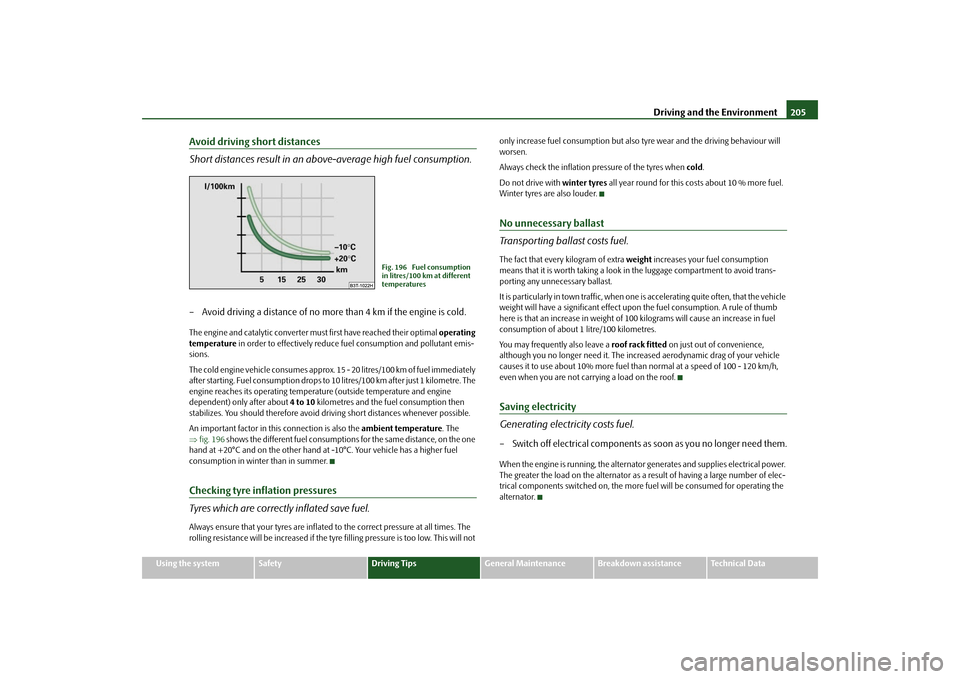
Driving and the Environment
205
Using the system
Safety
Driving Tips
General Maintenance
Breakdown assistance
Technical Data
Avoid driving short distances Short distances result in an above-average high fuel consumption.– Avoid driving a distance of no more than 4 km if the engine is cold.The engine and catalytic converter mu
st first have reached their optimal
operating
temperature
in order to effectively reduce fu
el consumption and pollutant emis-
sions. The cold engine vehicle consumes approx. 15 - 20 litres/100 km of fuel immediately after starting. Fuel co
nsumption drops to 10 litres/100 km after just 1 kilometre. The
engine reaches its operating temperat
ure (outside temperature and engine
dependent) only after about
4 to 10
kilometres and the fuel consumption then
stabilizes. You should therefore avoid driving short distances whenever possible. An important factor in this connection is also the
ambient temperature
. The
⇒ fig. 196
shows the different fuel consumptions for the same distance, on the one
hand at +20°C and on the other hand at
-10°C. Your vehicle has a higher fuel
consumption in winter than in summer.Checking tyre inflation pressures Tyres which are correctly inflated save fuel.Always ensure that your tyres are inflated
to the correct pressure at all times. The
rolling resistance will be increased if the tyre filling pressure is too low. This will not
only increase fuel consumption but also
tyre wear and the driving behaviour will
worsen. Always check the inflation pressure of the tyres when
cold
.
Do not drive with
winter tyres
all year round for this costs about 10 % more fuel.
Winter tyres are also louder.No unnecessary ballast Transporting ballast costs fuel.The fact that every kilogram of extra
weight
increases your fuel consumption
means that it is worth taking a look in the luggage compartment to avoid trans- porting any unnecessary ballast. It is particularly in town traffic, when one
is accelerating quite often, that the vehicle
weight will have a significant effect upon
the fuel consumption. A rule of thumb
here is that an increase in weight of 100
kilograms will cause an increase in fuel
consumption of about 1
litre/100 kilometres.
You may frequently also leave a
roof rack fitted
on just out of convenience,
although you no longer need it. The incr
eased aerodynamic drag of your vehicle
causes it to use about 10% more fuel th
an normal at a speed of 100 - 120 km/h,
even when you are not carr
ying a load on the roof.
Saving electricity Generating electricity costs fuel.– Switch off electrical components as
soon as you no longer need them.
When the engine is running, the alternator
generates and supplies
electrical power.
The greater the load on the alternator as a result of having a large number of elec-trical components switched on, the more
fuel will be consumed for operating the
alternator.
Fig. 196 Fuel consumption in litres/100 km at different temperatures
s2dk.1.book Page 205 Wednesday, April 8, 2009 12:23 PM
Page 207 of 294

Driving and the Environment
206
Keeping a log of your fuel consumptionIf you really wish to ke
ep a close check on your
fuel consumption
, it is best to enter
the figures in a logbook. This does not take
much time but is a very worthwhile exer-
cise. It enables you to detect any change
(positive and negative) at an early stage
and to take any appropriate action. If you find that your fuel
consumption is too high, you sh
ould reflect on how, where
and in what conditions you have driven
the vehicle since you last refuelled.
Environmental compatibilityEnvironmental protection has played a majo
r role in the design, selection of mate-
rials and manufacture of your new Škoda.
Particular emphasis
has been paid to a
number of aspects, including: Design measures•
joints designed to be easily detached,
•
simplified disassembly due to the modular structure system,
•
improved purity of different classes of materials,
•
Identification of all plastic parts in
accordance with VDA Recommendation 260,
•
Reduced fuel consumption
and exhaust emission CO
2,
•
Minimum fuel leakage during accidents,
•
Reduced noise.
Choice of materials•
extensive use of recyclable material,
•
Air conditioning filled wi
th CFC-free refrigerant,
•
no cadmium,
•
no asbestos,
•
Reduction in the “vaporisation” of plastics.
Manufacture•
solvent-free cavity protection,
•
solvent-free protection of the vehicle for transportation from the production
plant to the customer,•
The use of solvent-free adhesives,
•
No CFCs used in the production process,
•
without use of mercury,
•
Use of water-soluble paints.
Motoring abroadGeneral Other circumstances may exist abroad.It is also possible, in certain countries, that the Škoda Service Partner network is limited or has not been established yet.
This is the reason why obtaining certain
spare parts may be somewhat complicate
d and specialist garage personnel may
o n l y b e a b l e t o m a ke l i m i te d re p a i rs . Š ko d a A u to i n t h e C z e c h R e pu b l i c a n d re l e v a n t importers are happy to provide information
about technical aspects of the vehicle,
required maintenance work and possibilities for getting repairs done.Unleaded petrolA vehicle fitted with a petrol engine must always be refuelled with unleaded petrol ⇒ page 202. The automobile associations can provide you with information regarding the locations of filling stations which offer unleaded petrol.HeadlightThe low beam of your headlights is set asym
metrically. It illuminates the side of the
road on which you are driving to a greater
extent. If you drive abroad on the other
side of the road, you wi
ll dazzle oncoming traffic.
In order to prevent the dazzling of oncoming
traffic, it is necessary that an adjust-
ment of the headlights is carried out by
your authorised Škoda Service Partner.
s2dk.1.book Page 206 Wednesday, April 8, 2009 12:23 PM
Page 210 of 294
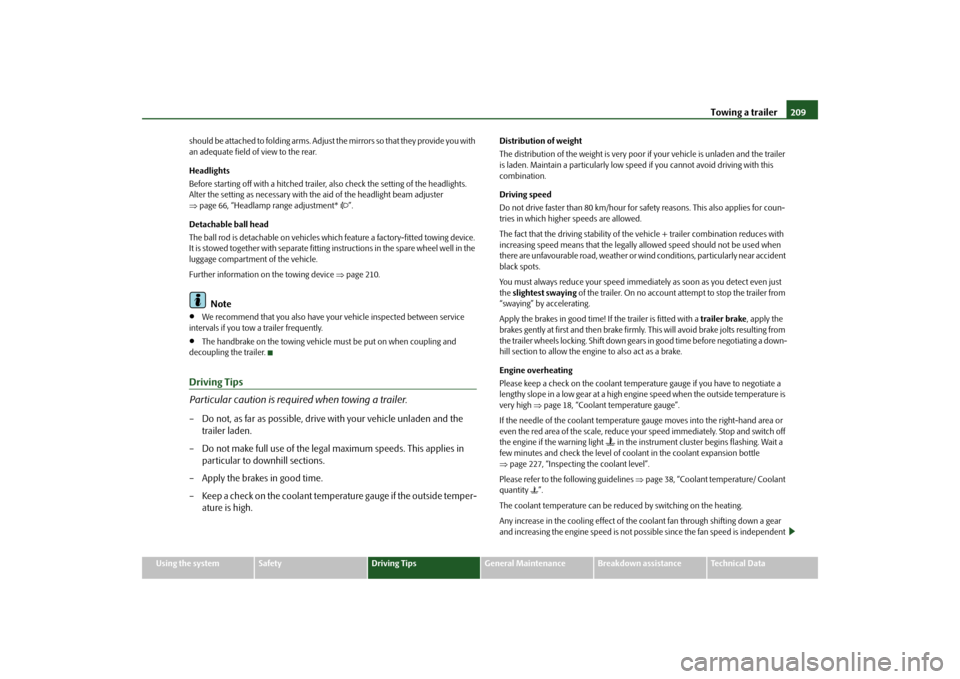
Towing a trailer
209
Using the system
Safety
Driving Tips
General Maintenance
Breakdown assistance
Technical Data
should be attached to folding arms. Adjust
the mirrors so that they provide you with
an adequate field of view to the rear. Headlights Before starting off with a hitched trailer, also check the setting of the headlights. Alter the setting as necessary with th
e aid of the headlight beam adjuster
⇒ page 66, “Headlamp range adjustment*
”.
Detachable ball head The ball rod is detachable on vehicles which feature a factory-fitted towing device. It is stowed together with separate fitting instructions in the spare wheel well in the luggage compartment of the vehicle. Further information on the towing device
⇒page 210.
Note
•
We recommend that you also have yo
ur vehicle inspected between service
intervals if you tow a trailer frequently.•
The handbrake on the towing vehicle
must be put on when coupling and
decoupling the trailer.Driving Tips Particular caution is required when towing a trailer.– Do not, as far as possible, drive
with your vehicle unladen and the
trailer laden.
– Do not make full use of the legal maximum speeds. This applies in
particular to downhill sections.
– Apply the brakes in good time.– Keep a check on the coolant temper
ature gauge if the outside temper-
ature is high.
Distribution of weight The distribution of the weight is very poor
if your vehicle is
unladen and the trailer
is laden. Maintain a particularly low speed if you cannot avoid driving with this combination. Driving speed Do not drive faster than 80 km/hour for safety reasons. This also applies for coun- tries in which higher speeds are allowed. The fact that the driving stability of the vehicle + trailer combination reduces with increasing speed means that the legally allowed speed should not be used when there are unfavourable road, weather or wind
conditions, particul
arly near accident
black spots. You must always reduce your speed immedi
ately as soon as you detect even just
the
slightest swaying
of the trailer. On no account attempt to stop the trailer from
“swaying” by
accelerating.
Apply the brakes in good time! If the trailer is fitted with a
trailer brake
, apply the
brakes gently at first and then brake firmly
. This will avoid brake jolts resulting from
the trailer wheels locking. Shift down gears
in good time before negotiating a down-
hill section to allow the engine to also act as a brake. Engine overheating Please keep a check on the coolant temperature gauge if you have to negotiate a lengthy slope in a low gear at a high engine speed when the outside temperature is very high
⇒page 18, “Coolant temperature gauge”.
If the needle of the coolant temperature gauge moves into the right-hand area or even the red area of the scale, reduce yo
ur speed immediately. Stop and switch off
the engine if the warning light
in the instrument cluste
r begins flashing. Wait a
few minutes and check the level of coolant in the coolant expansion bottle ⇒ page 227, “Inspecting the coolant level”. Please refer to the following guidelines
⇒page 38, “Coolant temperature/ Coolant
quantity
”.
The coolant temperature can be reduced by switching on the heating.Any increase in the cooling effect of the coolant fan through shifting down a gear and increasing the engine speed is not possible since the fan speed is independent
s2dk.1.book Page 209 Wednesday, April 8, 2009 12:23 PM
Page 224 of 294
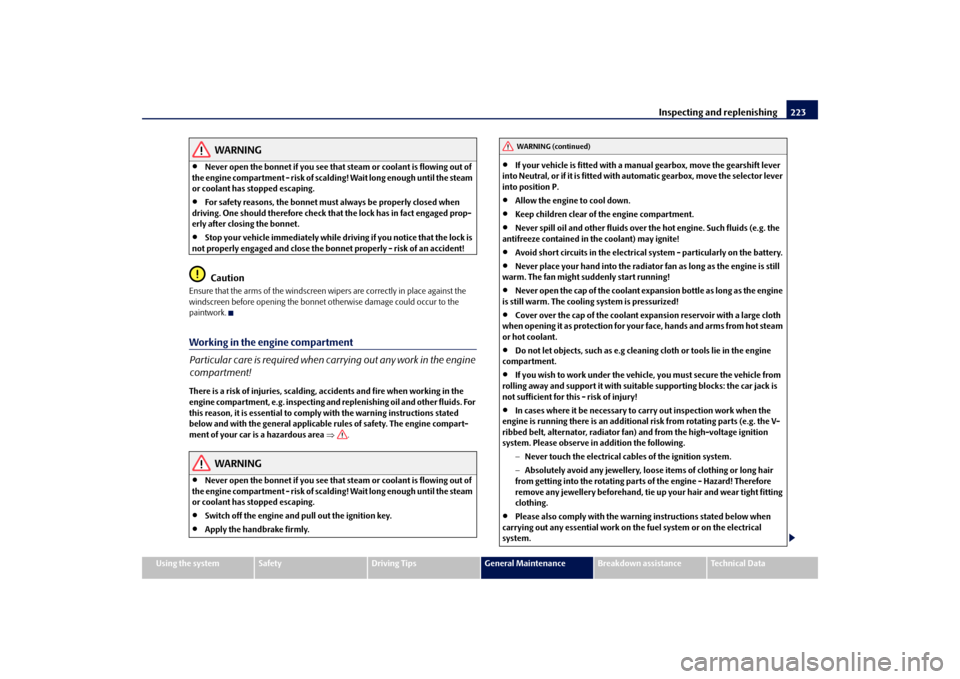
Inspecting and replenishing
223
Using the system
Safety
Driving Tips
General Maintenance
Breakdown assistance
Technical Data
WARNING
•
Never open the bonnet if you see that steam or coolant is flowing out of
the engine compartment - risk of scaldi
ng! Wait long enough until the steam
or coolant has stopped escaping.•
For safety reasons, the bonnet must always be properly closed when
driving. One should therefore check that
the lock has in fact engaged prop-
erly after closing the bonnet.•
Stop your vehicle immediately while driv
ing if you notice that the lock is
not properly engaged and close the bonne
t properly - risk of an accident!
Caution
Ensure that the arms of the windscreen
wipers are correctly
in place against the
windscreen before opening the bonnet otherwise damage could occur to the paintwork.Working in the engine compartment Particular care is required when carrying out any work in the engine compartment!There is a risk of injuries, scalding,
accidents and fire when working in the
engine compartment, e.g. inspecting and replenishing oil and other fluids. For this reason, it is essential to comply with the warning instructions stated below and with the general applicable
rules of safety. The engine compart-
ment of your car is a hazardous area
⇒
.
WARNING
•
Never open the bonnet if you see that steam or coolant is flowing out of
the engine compartment - risk of scaldi
ng! Wait long enough until the steam
or coolant has stopped escaping.•
Switch off the engine and pull out the ignition key.
•
Apply the handbrake firmly.
•
If your vehicle is fitted with a ma
nual gearbox, move the gearshift lever
into Neutral, or if it is fitted with
automatic gearbox, move the selector lever
into position P.•
Allow the engine to cool down.
•
Keep children clear of the engine compartment.
•
Never spill oil and other fluids over the hot engine. Such fluids (e.g. the
antifreeze contained in the coolant) may ignite!•
Avoid short circuits in the electrical system - particularly on the battery.
•
Never place your hand into the radiator fan as long as the engine is still
warm. The fan might suddenly start running!•
Never open the cap of the coolant expa
nsion bottle as long
as the engine
is still warm. The cooling system is pressurized!•
Cover over the cap of the coolant expansion reservoir with a large cloth
when opening it as protection for your
face, hands and arms from hot steam
or hot coolant.•
Do not let objects, such as e.g cleani
ng cloth or tools lie in the engine
compartment.•
If you wish to work under the vehicle, you must secure the vehicle from
rolling away and support it with suitable supporting blocks: the car jack is not sufficient for this - risk of injury!•
In cases where it be necessary to carry out inspection work when the
engine is running there is an additional risk from rotating parts (e.g. the V- ribbed belt, alternator, radiator fan) and from the high-voltage ignition system. Please observe in addition the following.
− Never touch the electrical cabl
es of the ignition system.
− Absolutely avoid any jewellery, loose items of clothing or long hair from getting into the rotating parts of the engine - Hazard! Therefore remove any jewellery beforehand, tie up your hair and wear tight fitting clothing.
•
Please also comply with the warnin
g instructions stated below when
carrying out any essential work on th
e fuel system or on the electrical
system.
WARNING (continued)
s2dk.1.book Page 223 Wednesday, April 8, 2009 12:23 PM
Page 225 of 294
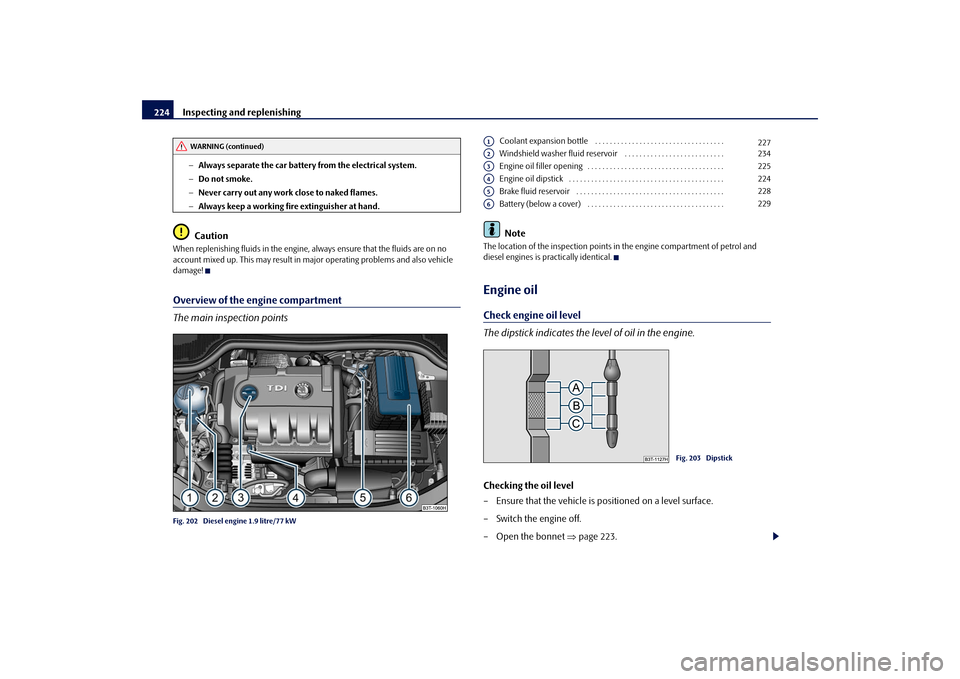
Inspecting and replenishing
224
−Always separate the car batter
y from the electrical system.
− Do not smoke. − Never carry out any work close to naked flames. − Always keep a working fire
extinguisher at hand.
Caution
When replenishing fluids in the engine, always ensure that the fluids are on no account mixed up. This may result in ma
jor operating problems and also vehicle
damage!Overview of the engine compartment The main inspection pointsFig. 202 Diesel engine 1.9 litre/77 kW
Coolant expansion bottle . . . . . . . . . . . . . . . . . . . . . . . . . . . . . . . . . . . Windshield washer fluid reservoir . . . . . . . . . . . . . . . . . . . . . . . . . . . Engine oil filler opening . . . . . . . . . . . . . . . . . . . . . . . . . . . . . . . . . . . . . Engine oil dipstick . . . . . . . . . . . . . . . . . . . . . . . . . . . . . . . . . . . . . . . . . . Brake fluid reservoir . . . . . . . . . . . . . . . . . . . . . . . . . . . . . . . . . . . . . . . . Battery (below a cover) . . . . . . . . . . . . . . . . . . . . . . . . . . . . . . . . . . . . . Note
The location of the inspection points in
the engine compartment of petrol and
diesel engines is practically identical.Engine oilCheck engine oil level The dipstick indicates the level of oil in the engine.Checking the oil level – Ensure that the vehicle is positioned on a level surface. – Switch the engine off. – Open the bonnet
⇒
page 223.
WARNING (continued)
A1
227
A2
234
A3
225
A4
224
A5
228
A6
229
Fig. 203 Dipstick
s2dk.1.book Page 224 Wednesday, April 8, 2009 12:23 PM